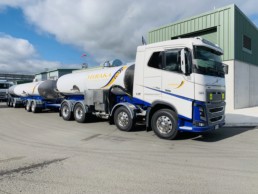Flo-gineering has been the market leader in the development of flow metering and data acquisition systems for stationary and mobile installations for over 30 years.
We are the Australian, New Zealand and American distributor for Poul Tarp A/S technologies from Denmark. Our flow metering systems can be installed in new or existing tankers. All systems we provide are approved for trade use in Australia, New Zealand and we have 3A Approval in the USA and pending approval from the stringent National Technology Evaluation Program certification.

Improved accuracy
Provides accurate and independent measurement of milk collected and discharged.

Eliminates Unfair Supplier payments
Dipsticks have been proven inaccurate, but with our technology, the Supplier is paid for exactly the volume of milk received.

Faster Pumping
Less load time. Saves valuable collection time as no data is manually recorded by the operator.

Representative Sampling
No more quality issues. Automatic sampling for both supplier and load samples.

Eliminate Human Error
Zero data entry error by driver or admin personnel. The data transfer operation allows factories to consolidate data in real time and reduce the need for manual data entries and the possibility of human error that can occur.

Features that get the job done
The In-built GPS module is used for tracking, supplier identification and factory location ensuring traceability of every gallon collected.
Our computer has a very intuitive screen for drivers to quickly adapt to. And no paperwork is required throughout the process which dramatically reduces errors.
A Bubble detector that detects air bubbles during the collection process is used to ensure correct pump speed providing superior accuracy and higher flow rates.
A Pressure sensor is used to detect vacuum that can cause cavitation which could lead to inaccurate volumes and damage to the equipment and product.
A Temperature sensor is used to monitor and record product temperature.
Additional conductivity sensors that can differentiate between milk, air and water is used to improve the accuracy of the milk volume counted, and an RPM sensor is used to control the speed of the pumps so that the collection speed is optimized without damaging the milk collected.
How the system works
Installing the system
The farm milk collection truck is fitted with a sophisticated milk flow metering and data acquisition system. At all times, the truck is connected to a remote server via the internet and data is being sent to and from the truck’s computer. So when the truck arrives at a supplier farm, the computer uses GPS location software to advise the driver of the name and number of this supplier. The computer suggests how much milk should be collected based on the average collected over the previous three days. The driver can accept this volume of edit the volume on screen.


Better data leads to better management
This expected volume is used by the computer to control the rate of sampling so a perfectly representative sample of milk is collected from each farm. The driver connects a hose to the farm tank and the pumps begin collecting this milk at very high speed. Both temperature and volume are constantly monitored throughout the collection process. The computerised printer prints a barcode label for each sample bottle so that this data is carefully monitored. At the end of the collection, the pumps stop and the driver retrieves the hose.
The samples collected are placed in an ice chest and the printer then prints a collection receipt which is left behind so the farmer can review the collection volume and temperature. This receipt will also print out the laboratory results from the previous day’s collection which is very important quality data for the farmer. As the truck departs from the farm, the data has already been sent back to the processing dairy’s server where the data will then be sent to the milk payment application so that the farmer is automatically paid for each load collected.
It's an Equitable Process
Everyone wins here – the farmer gets paid for exactly what is collected. The Dairy pays for exactly what is collected and the data is captured without any human intervention.
We save millions for milk processing companies
Our detailed and real life study shows it step by step how a milk processing company can benefit from our solutions.

We save millions for milk processing companies
Our detailed and real life study shows it step by step how a milk processing company can benefit from our solutions.



